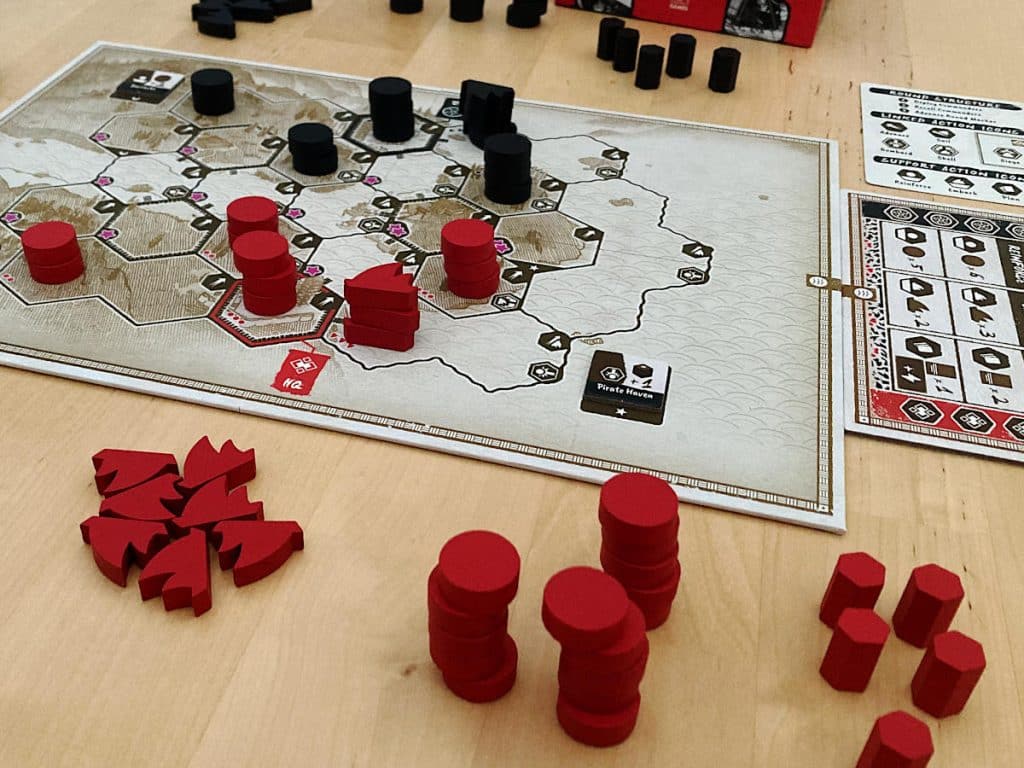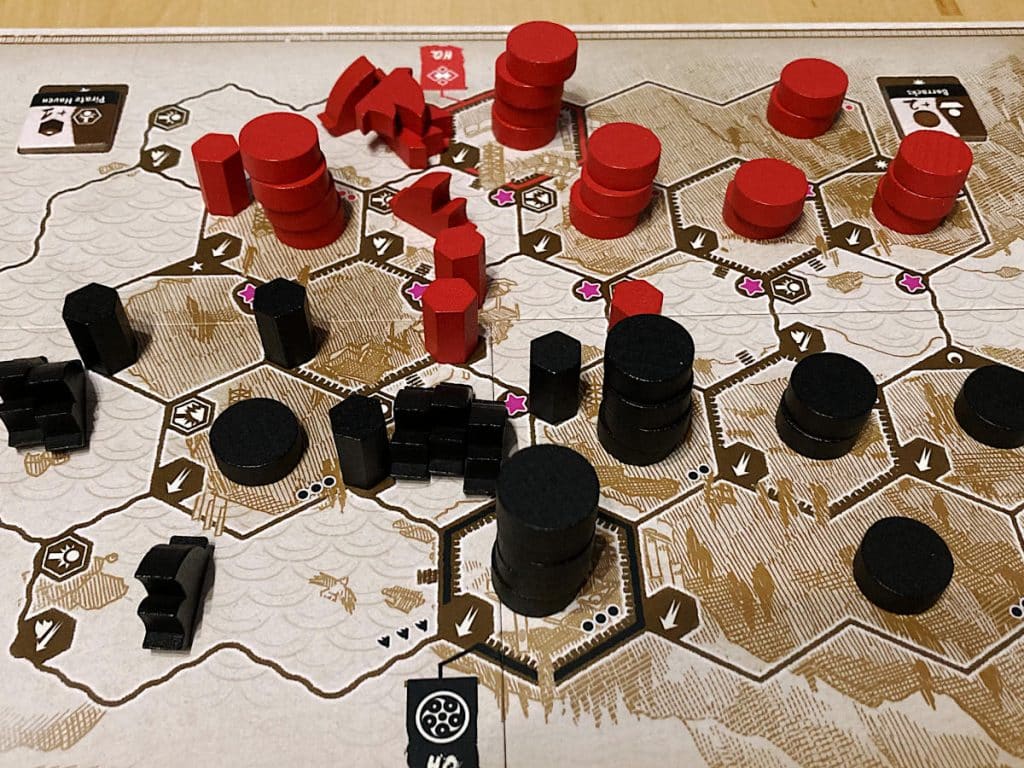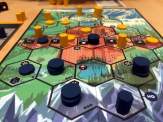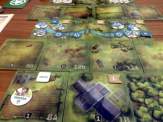| Release Date: 2025 | Players: 2 (only) |
| Designer: David Thompson, Trevor Benjamin | Length: 15-45 minutes |
| Artist: Tanner Staheli | Age: 12+ |
| Publisher: Osprey Games | Complexity: 2.5 / 5 |
| Plastic (by weight): <1% | Air (by volume): 15% |
The land was divided, its provinces fractured by ambition and betrayal. Armies marched through rice fields, emissaries whispered in candlelit halls, and the people looked to their daimyo for guidance and protection. Every order carried the weight of loyalty and the promise of power. It was a time when each decision could tilt the balance of history, and so the samurai sent out their General Orders: Sengoku Jidai by David Thompson and Trevor Benjamin from Osprey Games with art by Tanner Staheli.
Listen to the Audio Version
Intro Music: Bomber (Sting) by Riot (https://www.
Music by https://www.
License code: HVGMBA9NX5PHIG8A
Artist: : Benjamin Tissot
Music: “Victory” by AShamaluevMusic.
Website: https://www.
Commanders in the Mist
General Orders: Sengoku Jidai is set during the so-called Warring States Period of Japan, a time of civil war and political upheaval from 1467 to 1615. At its heart, it is a two-player strategic battle of clever positioning, perfect timing, and unwavering nerves. Each player takes on the role of a daimyo who commands their private army and seeks dominance over a stretch of war-torn Japan. With only a handful of tokens and a limited number of rounds, every choice matters.
The design builds upon the framework established by its predecessor, General Orders: World War II, introducing very small but very significant variations. Anyone who has played the earlier game will find this one immediately familiar and easy to learn, while still offering enough differences to keep it fresh.
Both are games of tactical warfare that are dressed in the robes of worker placement and area control. You assign commanders to an action space, triggering a specific manoeuvre that affects that hex. With each of the four rounds granting only five or six commanders, you have a total of only twenty or twenty-four actions to shape the fate of your ambitions and your army. It forces you to focus on what is important right now and look ahead to open up your strategic and tactical options. Yet, every command token you place also signals important information to your opponent.
Despite the simple ruleset, the map and its geography take time to master. Rivers define natural choke points, star-marked spaces hold strategic value, because controlling them at the end of the game decides victory, and every hex has different potential for movement and control. Learning when to press forward, what locations to hold and how to protect your supply lines is the heartbeat of General Orders: Sengoku Jidai.

Rivers, Roads, and Rivalries
The map’s elegance lies in its restraint. It is a modest board. It is not only small in its dimensions, but it is also austere in design. Yet, every space matters. The muted artwork is easy to parse, while the aesthetic evokes the setting’s cultural tone without being distracting. General Orders: Sengoku Jidai is beautiful to look at, but not overly busy to make it hard to play. The compact design continues with the tokens, which are sturdy wooden pieces, perfectly scaled for a compact battlefield. As a result, the game fits into a relatively small box and requires very little table space, but still opens up vast possibilities once play begins.
One of the additions in General Orders: Sengoku Jidai are boats and rivers. Boats can carry ground troops across, but their greatest potential lies in chaining movement along river routes, creating lanes of rapid manoeuvre. Control of these waterways can rapidly transform a defensive position into a devastating strike. The additional mobility and logistics this creates feel authentic, representing the challenges of maintaining supply lines and exploiting terrain the daimyo faced in their time.
Like in its predecessor, supply is also a key mechanism in General Orders: Sengoku Jidai. Each area you control must remain connected to your headquarters, or your forces will struggle to hold their ground and will be starved of fresh troops. The ability to cut off supply lines results in palpable tension. You constantly weigh the benefits of expanding your reach against the danger of overextending your army. A single cut supply line can undo even the most carefully considered plan. It is a suitable reminder that ambition without support leads to collapse.
Quiet Tension and Sudden Clashes
Early turns in General Orders: Sengoku Jidai are slow and methodical. Players reinforce their positions and move out to control key strategic points.
After the initial testing and probing, the middle game inevitably erupts into skirmishes, retreats, and exchanges of territory. Once a battle begins, its resolution is always swift and usually hugely impactful. Like in its predecessor, it is the defender who rolls dice to determine how many of the attacking units are defeated. After that, it is a simple matter of subtraction. Take the lower number of units away from the higher, and you get the remaining units that are left in the hex. It is the player with the higher number who then controls the territory. It is really quick and simple, but the result is always devastating, with units on both sides greatly decimated, whatever the dice roll.
What makes battles so special is the restriction of the worker placement mechanism. Once a player has used the Advance or Sail action space to attack, the opponent cannot repeat that move until the next round. So if you manage to successfully invade your opponent’s territory, they will not be able to immediately counterattack. That creates a very organic ebb and flow, forcing both players to plan not only their current strike, but how they can reinforce the newly gained region.
The token limit further reinforces the tension. You can never flood the board, and each hex has its own unit cap. It is impossible to stack endlessly, unlike in some other war games. It keeps the focus sharp and the pacing brisk. The fixed four-round structure finally ensures the game reaches a conclusion within an hour, often less. Yet, those brief minutes are filled with decisions and counter-decisions that create excitement and nervous pressure at the same time.

Chess on the Japanese Plains
The more you play General Orders: Sengoku Jidai, the more you realise how much strategic depth it offers. Like chess, early moves are about establishing your position, the middle game explodes with exchanges and devastating losses, while the endgame demands perfect precision. After every game, you will reflect on your openings, tactics, and the endgame. Yet, General Orders: Sengoku Jidai compresses the full three-act experience into a quick four rounds.
It is amazing how such a small box demands so much thought and focus. The more you play, the more patterns you will see, the more you discover how certain openings influence the mid-game, how cutting a single supply line can collapse the opponent’s whole army. Yet no two plays are ever the same. Just like chess, General Orders: Sengoku Jidai is a conversation between you and your opponent. You each study the other player’s ability to adapt and anticipate, and you both evolve with every encounter.
General Orders: Sengoku Jidai is a great example of distilled design. It captures the feeling of executing a massive strategy in a space of less than an hour, within which the drama of conquest and clever planning unfolds. It is perfect for those who love tight and tense two-player contests.
If you played World War II, the transition to Sengoku Jidai is pretty effortless. The backbone remains the same, yet the change in setting and the addition of a couple of new elements and mechanisms give it a very fresh feel. If you loved World War II, then give its successor a go. If you were always interested in finding out how such a small box can offer so much gameplay, then definitely get yourself a copy of General Orders: Sengoku Jidai. I really don’t think you will be disappointed.
For behind-the-scenes updates, branded merchandise, and more, please support the blog.
Useful Links
- General Orders: Sengoku Jidai: https://www.
ospreypublishing. com/ uk/ general-orders-sengoku-jidai-9781472869791/ - Rulebook: https://boardgamegeek.
com/ filepage/ 306284/ general-orders-sengoku-jidai-rulebook - Rules video: https://www.
youtube. com/ live/ c3VNMR7NTsE? si= yEAXWfVlr4Kirl_ D& amp;t= 265 - Osprey Games: https://www.
ospreypublishing. com/ uk/ - BGG listing: https://boardgamegeek.
com/ boardgame/ 434425/ general-orders-sengoku-jidai - General Orders: World War II review: https://tabletopgamesblog.
com/ 2024/ 02/ 17/ general-orders-world-war-ii-saturday-review/
Videos
Transparency Facts
- I was given a free review copy of this game by the publisher.
- At the time of writing, I have not received financial support from the publisher or anyone working on their behalf.
Audio Version
Intro Music: Bomber (Sting) by Riot (https://www.
Music by https://www.
License code: HVGMBA9NX5PHIG8A
Artist: : Benjamin Tissot
Music: “Victory” by AShamaluevMusic.
Website: https://www.
Playlist
These are the songs I listened to while I was writing this review:






